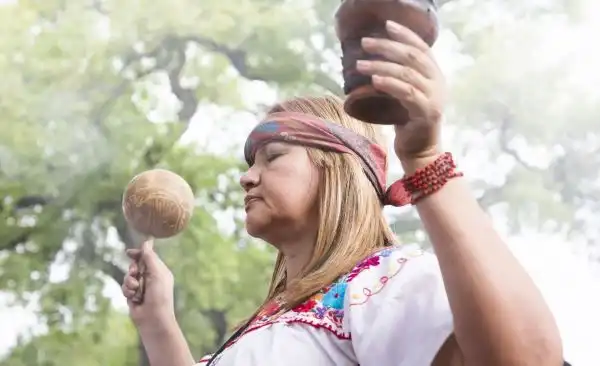Where did curanderismo originate? This question carries profound significance for those seeking to understand the roots of one of the Americas’ most enduring healing traditions. Many people turn to this ancient practice without fully grasping the rich tapestry of cultures and wisdom that birthed it.
María del Pilar Fernández, drawing from her lifelong immersion in curandera traditions and her studies in cultural anthropology, believes that understanding curanderismo’s origins illuminates not just historical knowledge, but the sacred pathways our ancestors traveled to preserve healing wisdom across centuries of transformation and trauma. Through this understanding, she seeks to answer where did curanderismo originate and honor the countless healers who carried these traditions forward.
For broken hearts, you should read “Can curandera heal heartbroken people?”
Where did curanderismo originate?
Curanderismo originated in the Archaic Period of Mesoamerica, with roots dating back thousands of years before Spanish colonization. This profound healing system emerged from the sophisticated medical knowledge of indigenous civilizations including the Mexica, Huaxtec, Toltec, Zapotec, Mixtec, and Maya, before evolving into the syncretic practice we recognize today through centuries of cultural blending.

Pre-Columbian foundations
The earliest foundations of curanderismo emerged from the sophisticated healing traditions of Mesoamerica’s indigenous peoples. Around 1,200 BCE, the Olmec civilization founded the first cities and demonstrated evidence of advanced surgical procedures. Archaeological discoveries reveal that these ancient healers possessed remarkable knowledge of human anatomy, herbal medicine, and spiritual healing practices.
Olmec, Zapotec, Maya and Aztec civilizations used peyote, hallucinogenic mushrooms (teonanacatl: Psilocybe spp.) and the seeds of ololiuhqui (Turbina corymbosa), that contain mescaline, psilocybin and lysergic acid amide, respectively. These sacred plant medicines were employed in healing ceremonies that addressed not just physical ailments, but the spiritual and emotional dimensions of illness.
The Mexica civilization, often called the Aztec Empire, developed particularly sophisticated healing philosophies. Mexica medicine included the belief that wellness required scheduling time in a very specific way: ideally, 70% of activities were devoted to physical, mental and spiritual self-care, while the remaining 30% would be devoted to serving family and community. This holistic approach recognized that true healing required balance between individual wellbeing and community service.
The sacred role of indigenous healers
Before European contact, indigenous healers held sacred positions within their communities. These healers, known by various names across different cultures, understood illness as arising from multiple sources: spiritual imbalance, environmental disharmony, emotional trauma, and loss of connection to the sacred. Their worldview recognized that disease and illness were rooted in emotion, environmental imbalance or disharmony, malevolent forces, spiritual disconnection or loss of soul.
The healing practices incorporated complex understanding of plant medicines, energy work, ceremonial cleansing, and community healing. Temazcal (sweat lodge) ceremonies provided psychological, physiological, and spiritual healing. Ritual burials of negative emotions offered therapeutic release from trauma—practices that contemporary research now validates as effective treatments for conditions like post-traumatic stress disorder.
Spanish colonization and Catholic influence
The Spanish conquest of 1521 marked a dramatic transformation in indigenous healing practices. Curanderismo as we know it today is a syncretic form of Mexican folk healing whose origins date back to the Spanish colonization of the Americas, drawing from both indigenous healing practices and Catholic spirituality.
Rather than completely destroying indigenous medicine, colonization created a complex fusion. Catholic elements became woven into existing healing frameworks: holy water and pictures of saints; San Martin de Porres for example is heavily employed within Peruvian curanderismo. The use of Catholic prayers and other borrowings and lendings is often found alongside native religious elements.
This syncretic blending allowed indigenous healing wisdom to survive under the protective cover of acceptable Catholic practice. Curanderas learned to invoke saints alongside traditional spirits, to use holy water in cleansing rituals, and to frame their work within Christian cosmology while maintaining the essential indigenous understanding of holistic healing.
African and Islamic contributions
Curanderismo’s origins also include West and East African traditions brought by Black peoples once enslaved in the region and Islamic medical science, which was practiced in Spain until the Inquisition and infused with Asian and South Asian philosophies. These additional influences enriched the practice with sophisticated understanding of herbal medicine, energy healing, and spiritual protection.
African healing traditions contributed deep knowledge of plant medicines, rhythmic healing practices, and spiritual technologies for protection against malevolent forces. Islamic medical knowledge, preserved in Spain for centuries before the Inquisition, brought systematic approaches to diagnosis, treatment protocols, and understanding of the body’s energy systems.
Modern curanderismo: a living synthesis
Today’s curanderismo represents a remarkable synthesis of these diverse healing traditions. In Mexico, it is usually a synthesis of Mexican indigenous culture and beliefs, such as Mexika, Zapotec or Maya, and depending on the practitioner’s religious, cultural, and/or tribal background, it may or may not also have Catholic, Sephardic, and African influences.
Modern curanderas and curanderos continue to adapt these ancient practices to contemporary needs while maintaining their essential spiritual foundation. It is estimated that in parts of the United States, between 50-75% of Mexican Americans use Curanderismo or seek the help of a Curandera or Curandero, demonstrating the enduring relevance of these healing traditions.
The practice has evolved to address modern challenges including trauma, depression, anxiety, and chronic illness, while maintaining its core understanding that healing must address the whole person: body, mind, spirit, and community relationships. Contemporary curanderas often work alongside medical doctors, creating integrative approaches that honor both indigenous wisdom and modern medical knowledge.
The continuity of wisdom
Understanding curanderismo’s origins reveals how indigenous peoples preserved and transformed their healing wisdom across centuries of colonization, persecution, and cultural change. This remarkable continuity speaks to the profound effectiveness of these practices and the dedication of countless healers who risked their lives to maintain these traditions.
Each curandera today carries forward thousands of years of accumulated wisdom, adapted through generations of practice to meet the healing needs of contemporary communities. This living tradition continues to evolve while maintaining its essential commitment to holistic healing that honors the sacred interconnection of all life.
Disclaimer
Please note that Maria is not a physician, psychologist, or nurse. These culture-specific spiritual healing services are not meant to replace medical or psychological diagnosis and treatment. It is recommended that you see a licensed physician or licensed health care professional for any physical or psychological ailment you may have.
María del Pilar recently worked with Elena, a young mother experiencing persistent insomnia and anxiety following a difficult childbirth. After consulting with Elena’s physician to ensure medical needs were met, María performed a traditional limpia (spiritual cleansing) using ruda (rue) and copal incense. Through gentle conversation during the plática, Elena revealed deep fears about her worthiness as a mother—fears that had been passed down through generations of women in her family.
María guided Elena through a ritual of releasing these inherited burdens, using traditional prayers and the healing smoke of copal to cleanse her luminous body. Together, they created a small altar honoring Elena’s maternal lineage while setting intentions for breaking harmful generational patterns. Elena also received herbal teas prepared from manzanilla (chamomile) and toronjil (lemon balm) to support her nervous system naturally.
Within three weeks, Elena reported significant improvement in her sleep and a profound sense of peace about her role as a mother. The integration of curanderismo’s holistic approach—addressing spiritual, emotional, and physical dimensions simultaneously—provided healing that conventional treatment alone had not achieved. Elena continued working with both her physician and María, experiencing the benefits of honoring both medical science and ancestral wisdom in her healing journey.
